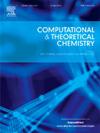Study of optical and nonlinear optical properties of symmetric/asymmetric benzo[d]oxazole derivatives under gas and solvent solute interaction models
IF 3
3区 化学
Q3 CHEMISTRY, PHYSICAL
引用次数: 0
Abstract
The oxazole class of organic compounds exhibits remarkable versatility, offering applications across a wide array of scientific and technological domains. In this current investigation we designed eight different derivatives of the benzo[d]oxazole (BOZ) class with different donor and acceptor groups substitutions named BOZ-1 to BOZ-8. Density functional theory (DFT) calculations are conducted, employing the M06/6-311G* level of study to determine the linear polarizability (α) and third-order NLO polarizability (<γ>) of the system. For BOZ-5, the isotropic linear polarizability (αiso) and anisotropic linear polarizability (αaniso) are calculated to be 90.52 × 10−24 esu and 147.4 × 10−24 esu respectively. Comparative analysis shows that BOZ-5 exhibits the highest value of <γ > amplitude, calculated to be 2844 × 10−36 esu. This increase in <γ > amplitude in BOZ-5 is due to the strategic placement of (![]() N(CH3)2) groups in the molecule and D-π-D configuration, which leads to maximum delocalization of electrons within the molecule. To study the influence of solvents on α and < γ>, advanced computational approaches such as polarizable continuum model (PCM) and the conductor-like screening model (COSMO) are employed to simulate both polar and non-polar solvent environments. When modeled in the COSMO-CH3OH environment, the αiso and < γ > amplitudes of BOZ-5 show values of 116.3 × 10−24 esu and 5575 × 10−36 esu, respectively, reflecting a notable ∼2-fold increase in <γ > amplitudes compared to their gas-phase counterparts. Furthermore, we performed dynamic <γ > response calculations to investigate the phenomenon of resonance enhancement using the dc-Kerr Effect and Electric Field-Induced Second Harmonic Generation (EFISHG) techniques. Time-dependent DFT calculations revealed that BOZ-5 exhibits the highest <γ > amplitude (2844 × 10−36 esu) and the lowest transition energy (3.02 eV) for the HOMO-LUMO transition among all compounds. A reduced orbital energy gap of 3.11 eV, along with electron density difference maps, molecular electrostatic potential diagrams, and density of state analysis, further supports that BOZ-5 exhibits the strongest intramolecular charge transfer (ICT) properties among all the designed compounds. In the assessment of photovoltaic parameters, it becomes evident that BOZ-5 stands out with the highest open circuit voltage (Voc) value recorded at 1.65, alongside the lowest ΔGreg value of 0.67 eV.
N(CH3)2) groups in the molecule and D-π-D configuration, which leads to maximum delocalization of electrons within the molecule. To study the influence of solvents on α and < γ>, advanced computational approaches such as polarizable continuum model (PCM) and the conductor-like screening model (COSMO) are employed to simulate both polar and non-polar solvent environments. When modeled in the COSMO-CH3OH environment, the αiso and < γ > amplitudes of BOZ-5 show values of 116.3 × 10−24 esu and 5575 × 10−36 esu, respectively, reflecting a notable ∼2-fold increase in <γ > amplitudes compared to their gas-phase counterparts. Furthermore, we performed dynamic <γ > response calculations to investigate the phenomenon of resonance enhancement using the dc-Kerr Effect and Electric Field-Induced Second Harmonic Generation (EFISHG) techniques. Time-dependent DFT calculations revealed that BOZ-5 exhibits the highest <γ > amplitude (2844 × 10−36 esu) and the lowest transition energy (3.02 eV) for the HOMO-LUMO transition among all compounds. A reduced orbital energy gap of 3.11 eV, along with electron density difference maps, molecular electrostatic potential diagrams, and density of state analysis, further supports that BOZ-5 exhibits the strongest intramolecular charge transfer (ICT) properties among all the designed compounds. In the assessment of photovoltaic parameters, it becomes evident that BOZ-5 stands out with the highest open circuit voltage (Voc) value recorded at 1.65, alongside the lowest ΔGreg value of 0.67 eV.

气体和溶质相互作用模型下对称/不对称苯并[d]恶唑衍生物的光学和非线性光学性质研究
恶唑类有机化合物表现出显著的多功能性,在广泛的科学和技术领域提供应用。在本研究中,我们设计了8种不同的苯并[d]恶唑(BOZ)类衍生物,它们具有不同的供体和受体取代基,命名为BOZ-1至BOZ-8。采用M06/6-311G*能级进行密度泛函理论(DFT)计算,确定了体系的线性极化率(α)和三阶NLO极化率(<γ>)。结果表明,BOZ-5的各向同性线性极化率αiso和各向异性线性极化率αaniso分别为90.52 × 10−24 esu和147.4 × 10−24 esu。对比分析表明,BOZ-5的<;γ >;振幅,计算为2844 × 10−36 esu。<γ >;BOZ-5中的振幅是由于(N(CH3)2)基团在分子中的策略性放置和D-π-D构型,这导致了分子内电子的最大离域。研究溶剂对α和<的影响;采用先进的计算方法,如极化连续介质模型(PCM)和类导体筛选模型(COSMO)来模拟极性和非极性溶剂环境。在cosmos - ch3oh环境中建模时,αiso和<;γ祝辞BOZ-5的振幅分别显示为116.3 × 10−24 esu和5575 × 10−36 esu,反映出<;γ >;与气相相比较的振幅。此外,我们执行了动态<;γ >;利用dc-Kerr效应和电场诱导二次谐波产生(EFISHG)技术研究共振增强现象的响应计算。时间相关DFT计算显示,BOZ-5表现出最高的<;γ >;在所有化合物中,HOMO-LUMO跃迁的振幅为2844 × 10−36 esu,跃迁能量为3.02 eV。轨道能隙减小到3.11 eV,电子密度差图、分子静电势图和态密度分析进一步支持BOZ-5在所有设计的化合物中表现出最强的分子内电荷转移(ICT)特性。在光伏参数的评估中,很明显,BOZ-5的开路电压(Voc)值最高,为1.65,最低的ΔGreg值为0.67 eV。
本文章由计算机程序翻译,如有差异,请以英文原文为准。
求助全文
约1分钟内获得全文
求助全文
来源期刊

Computational and Theoretical Chemistry
CHEMISTRY, PHYSICAL-
CiteScore
4.20
自引率
10.70%
发文量
331
审稿时长
31 days
期刊介绍:
Computational and Theoretical Chemistry publishes high quality, original reports of significance in computational and theoretical chemistry including those that deal with problems of structure, properties, energetics, weak interactions, reaction mechanisms, catalysis, and reaction rates involving atoms, molecules, clusters, surfaces, and bulk matter.
 求助内容:
求助内容: 应助结果提醒方式:
应助结果提醒方式:


